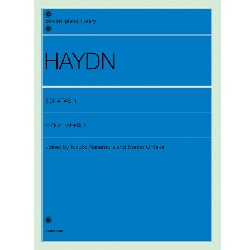Haydn, Franz Joseph : Sonate für Klavier Nr.33 c-moll Hob.XVI:20 op.30-6
Work Overview
Publication Year:1780
First Publisher:Artaria
Instrumentation:Piano Solo
Genre:sonata
Total Playing Time:16 min 00 sec
Copyright:Public Domain
Additional Notes:第33番は「ウィーン原典版」における番号
Commentary (1)
Author : Inada, Saeko
Last Updated: May 1, 2009
[Open]
Author : Inada, Saeko
Composed in 1771, it was published in 1780 by Artaria in Vienna as Op. 30, along with Hob. XVI: 35-39.
Five years prior to this composition, Haydn had been promoted to Kapellmeister for the Esterházy princely family. This meant he was solely responsible for all musical activities, while also being free to compose without constraint from anyone except the Prince. Consequently, Haydn began more ambitious endeavors across a wide range of genres than ever before. From this period into the early 1770s, various high-quality works were produced. It was a creative period marked by expressive works conveying emotions such as excitement and passion, with minor-key symphonies being particularly striking (often referred to as the 'Sturm und Drang' period).
This sonata, too, is a work of strong expressiveness in the key of C minor. Contributing to this are the syncopated rhythms and, particularly in the first movement, the indications for forte and piano. This sonata is one of Haydn's earliest works likely conceived for the fortepiano, at a time when the fortepiano was emerging as the dominant keyboard instrument while coexisting with the harpsichord. The dynamics, sometimes even showing sforzando effects, expand the work's expressiveness.
First Movement: (Allegro) Moderato, C minor, 4/4 time. Sonata form.
While the unsettling-sounding first theme has a standard phrase length of 4+4 measures, the second theme takes on a freer motion with phrase structures in units of three measures (sometimes with a one-measure transitional bar in between). In the development section, the stormy triplets from the exposition's coda are prominently used, heightening the tension.
Second Movement: Andante con moto, A-flat major, 3/4 time. Sonata form.
It begins with a gentle first theme that slowly expands in breadth from the very first note. In the developmental second theme, appoggiaturas and syncopation add rhythmic motion, while continuous syncopation in the melodic line, primarily based on stepwise motion, demands long, seemingly unending phrases.
Third Movement: Allegro, C minor, 3/4 time. Sonata form.
In contrast to the symphonic breadth of the first movement, this final movement features prominent pianistic elements. The eerie quality of the tiptoeing opening theme and the agitated feel of the sixteenth-note passages are striking. On the other hand, the cantabile character of the second theme eases the tension, and consonant thirds support the movement as a whole.
Movements (3)
PTNA & Partner Channel Videos(6items)
Sheet Music
Scores List (11)

(株)全音楽譜出版社

ヘンレー

(株)音楽之友社

ヘンレー

ヘンレー

ヘンレ社(ヤマハ)

ヘンレー

(株)音楽之友社

(株)音楽之友社








